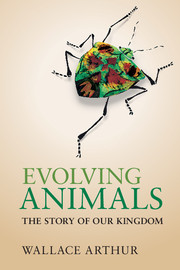Book contents
- Frontmatter
- Dedication
- Contents
- Preface
- Acknowledgements
- 1 What is an animal?
- 2 Before there were animals
- 3 How to make a fossil
- 4 The Cambrian explosion
- 5 How to make a species
- 6 Jellyfish and their kin
- 7 How to make a tree
- 8 The enigmatic urbilaterian
- 9 Animal symmetry and heads
- 10 A plethora of worms
- 11 Trends in animal complexity
- 12 Where the octopus is king
- 13 How to make an animal
- 14 Exoskeletons galore
- 15 Extinction
- 16 Mouth first, mouth second
- 17 Comparing embryos
- 18 Larvae, mouthparts and moulting
- 19 The animal toolkit
- 20 Vertebrate origins and evolution
- 21 From water to land to water
- 22 Variation and inheritance
- 23 Evolutionary novelties
- 24 Human origins and evolution
- 25 Animal plasticity
- 26 The nature of adaptation
- 27 The direction of evolution
- 28 Animal extremophiles
- 29 Extraterrestrial animals?
- 30 The ghost in the machine
- Appendix
- References
- Index
Appendix
Published online by Cambridge University Press: 05 August 2014
- Frontmatter
- Dedication
- Contents
- Preface
- Acknowledgements
- 1 What is an animal?
- 2 Before there were animals
- 3 How to make a fossil
- 4 The Cambrian explosion
- 5 How to make a species
- 6 Jellyfish and their kin
- 7 How to make a tree
- 8 The enigmatic urbilaterian
- 9 Animal symmetry and heads
- 10 A plethora of worms
- 11 Trends in animal complexity
- 12 Where the octopus is king
- 13 How to make an animal
- 14 Exoskeletons galore
- 15 Extinction
- 16 Mouth first, mouth second
- 17 Comparing embryos
- 18 Larvae, mouthparts and moulting
- 19 The animal toolkit
- 20 Vertebrate origins and evolution
- 21 From water to land to water
- 22 Variation and inheritance
- 23 Evolutionary novelties
- 24 Human origins and evolution
- 25 Animal plasticity
- 26 The nature of adaptation
- 27 The direction of evolution
- 28 Animal extremophiles
- 29 Extraterrestrial animals?
- 30 The ghost in the machine
- Appendix
- References
- Index
Summary
Throughout the book, I have adhered to a policy of keeping technical terms to a minimum. In particular, I have tried not to bury the reader in a mass of scientific names of animal groups and geological periods. I hope this has resulted in the main text being easier to read than it otherwise would have been. However, many readers will be curious to know how a particular geological period that has been referred to (e.g. Cambrian, Jurassic) fits into the bigger picture of geological time. Equally, many readers will want to see at a glance somewhere a list of the animal phyla that have been dealt with in this book (e.g. arthropods, chordates, molluscs), with a grouping of these that relates to their place in the hierarchical structure of the animal kingdom as a whole, and with an estimate of how many described species each currently has. Hence the following.
Geological time
The Earth is just over 4.5 billion years old. This span of time is divided up into four aeons: Hadean (4.5 to 4.0 billion years ago, BYA), Archaean (4.0 to 2.5 BYA), Proterozoic (2.5 to 0.542 BYA) and Phanerozoic (usually given in millions of years ago: 542 to 0 MYA). There are subdivisions of all four aeons, but we don’t need to know these for the first three, with a single exception: the end of the Proterozoic aeon, from about 635 to 542 MYA, is called the Ediacaran period, after the Ediacara Hills in South Australia, the site of the first discoveries of fossils of what have come to be known as the Ediacaran life-forms (not ‘animals’, as that remains uncertain). So the creatures themselves, the place where they were first found (though it’s now clear that they had a worldwide distribution) and the relevant period of geological time all bear the same name. This was not the case until quite recently, because ‘Vendian period’ was previously used for the approximate time span now called the Ediacaran.
- Type
- Chapter
- Information
- Evolving AnimalsThe Story of our Kingdom, pp. 319 - 323Publisher: Cambridge University PressPrint publication year: 2014



